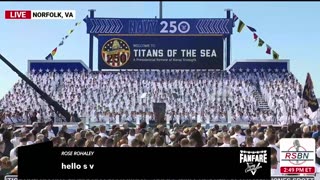Premium Only Content

ARES I-X FLIGHT LAUNCH TEST
The primary purpose of the Ares I-X test flight was to gather data on the flight dynamics and performance of the Ares I rocket's first stage. This test flight was critical in assessing the viability and safety of the Ares I design before proceeding with further development of the Constellation program.
Vehicle Configuration: The Ares I-X vehicle was not a fully functional rocket but rather a prototype that simulated the size, shape, and mass characteristics of the Ares I first stage. It featured a modified Peacekeeper missile solid rocket motor as its first stage and a dummy second stage to replicate the Ares I's appearance. The Orion Crew Module Launch Abort System (LAS) was also included on top of the second stage to test its functionality.
Launch Date: The Ares I-X test flight took place on October 28, 2009, from Launch Complex 39B at NASA's Kennedy Space Center in Florida.
Flight Profile: The Ares I-X flight followed a suborbital trajectory, meaning it did not reach orbit but rather achieved a high altitude before descending back to Earth. The flight lasted approximately six minutes, during which the vehicle went through several important phases, including ignition, ascent, separation, and descent.
Data Collection: The test flight gathered valuable data on the vehicle's aerodynamics, structural integrity, control systems, and performance throughout the flight. This data was used to evaluate the Ares I design and make necessary refinements.
Outcome: The Ares I-X test flight was considered successful in achieving its primary objectives. It provided important insights into the behavior of the Ares I first stage during ascent and validated some of the design assumptions. However, it was one of the final flights associated with the Constellation program, as the program was eventually canceled in favor of the Space Launch System (SLS) for future crewed missions beyond low Earth orbit.
The Ares I-X test flight marked a significant step in NASA's exploration efforts, even though the Ares I rocket was ultimately not selected for future missions. It contributed to the agency's understanding of crewed spaceflight technology and played a role in shaping the direction of NASA's future exploration endeavors.
-
 LIVE
LIVE
MrOldFart
8 hours ago $1.47 earnedLIVE - MEGABONK First Playthrough - Mr.OldFart
214 watching -
 9:06:53
9:06:53
GritsGG
9 hours agoWarzone Win Grinding! Most Wins in WORLD! 3680+!
74.1K1 -
![[LIVE] POST-SHOW | STAR WARS: Jedi Academy - Movie Battles 2 | ReaperAF95's Community Event Day 2](https://1a-1791.com/video/fwe2/ce/s8/1/E/Q/f/o/EQfoz.0kob-small-LIVE-STAR-WARS-Jedi-Academy.jpg) LIVE
LIVE
Joke65
6 hours ago[LIVE] POST-SHOW | STAR WARS: Jedi Academy - Movie Battles 2 | ReaperAF95's Community Event Day 2
21 watching -
 5:41:09
5:41:09
Right Side Broadcasting Network
2 days agoLIVE REPLAY: President Trump to Deliver Remarks at America's Navy 250 in Norfolk, VA - 10/5/25
140K72 -
 LIVE
LIVE
SynsFPS
7 hours ago🔴B07 Beta🔴|🔴 LEVEL CAP INCREASED 🔴|🔴Path to Verify 🔴
35 watching -
 LIVE
LIVE
tminnzy
7 hours ago*BETA DROPS* BO7 LEVEL CAP INCREASE! OPEN BETA
14 watching -
 1:06:42
1:06:42
The White House
9 hours agoPresident Trump Delivers Remarks at Navy 250 Celebration
56.1K59 -
 4:42:13
4:42:13
TinyPandaface
8 hours agoYour FACE is a Gaming Channel! | Homebody
25.2K -
 3:22:43
3:22:43
Barry Cunningham
10 hours agoBREAKING NEWS: PRESIDENT TRUMP GIVES SPEECH TO THE NAVY!
81.2K50 -
 6:29:33
6:29:33
EyeSeeU8
7 hours ago🔴Warzone + BO7 Beta w/ EyeSeeU
18.6K2
